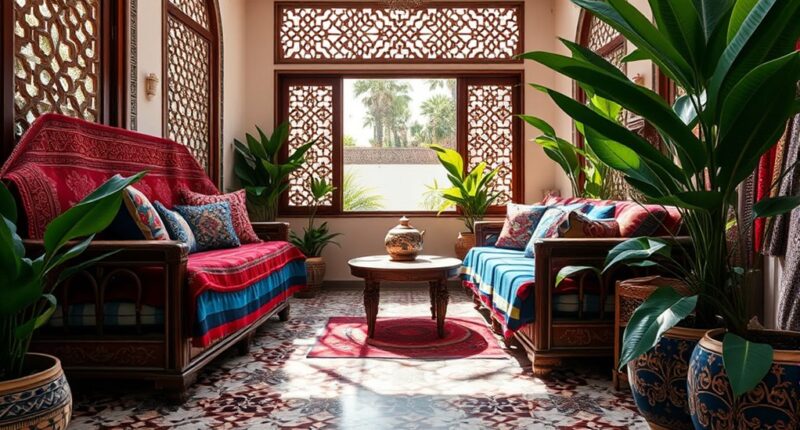Transform your home into a Moroccan oasis by incorporating vibrant textiles, intricate rugs, and bold tilework like Zellige. Use rich colors such as terracotta, deep blues, and gold accents to create warmth. Mix geometric patterns with natural materials for an authentic feel. Layer textiles and choose handcrafted decor to elevate your space. Keep exploring to discover how these beautiful elements can turn your home into a colorful, cultural sanctuary.
Key Takeaways
- Incorporate vibrant Moroccan textiles like kilims and embroidered wall hangings to add cultural richness and visual interest.
- Use hand-cut Zellige tiles with geometric patterns for authentic, colorful mosaic accents in kitchens and bathrooms.
- Layer textiles and tiles to create a warm, inviting atmosphere that reflects Morocco’s artistic heritage.
- Select natural dyes and eco-friendly fibers to enhance sustainability and authentic Moroccan craftsmanship.
- Enhance your space with Moroccan-inspired decor elements such as lanterns, cushions, and pottery for a true oasis feel.
Exploring the Rich Heritage of Moroccan Textiles
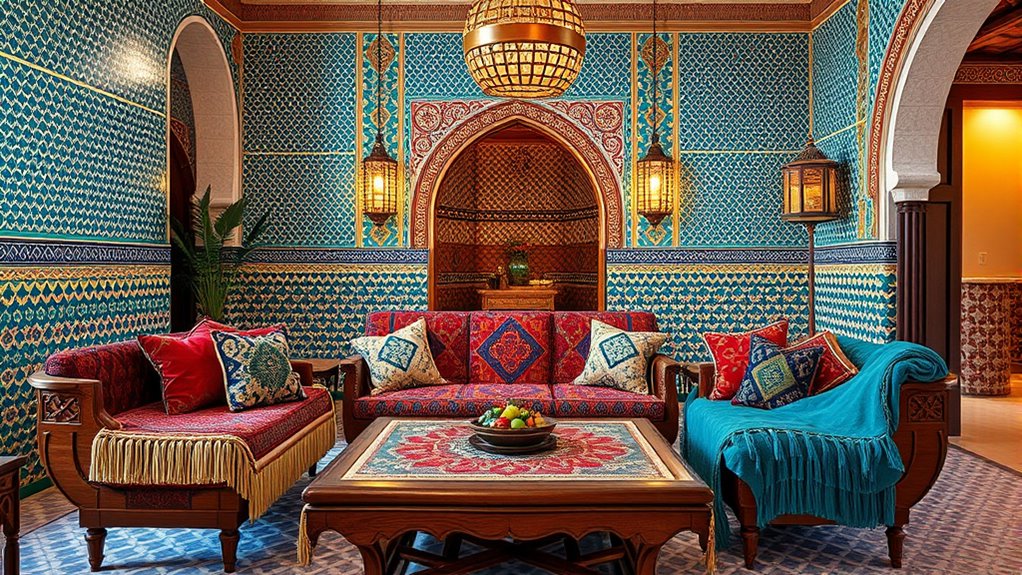
Have you ever wondered what makes Moroccan textiles so vibrant and unique? It’s the intricate Moroccan embroidery that brings life to each piece, showcasing centuries of craftsmanship. These textiles often feature desert-inspired color schemes, blending warm earth tones like terracotta, ochre, and sandy beige. Such colors evoke the vast Moroccan landscapes and create a warm, inviting atmosphere. Moroccan embroidery is characterized by bold geometric patterns and detailed stitches, reflecting cultural stories and traditions. This rich heritage is woven into everything from rugs to wall hangings, making each item a testament to the artistry passed down through generations. Additionally, the rich cultural heritage of Moroccan textiles is deeply connected to regional history and social customs, further emphasizing their significance. By appreciating the vibrant colors and detailed embroidery, you connect with Morocco’s deep cultural roots and its timeless textile craftsmanship.
Types of Moroccan Fabrics and Their Unique Features
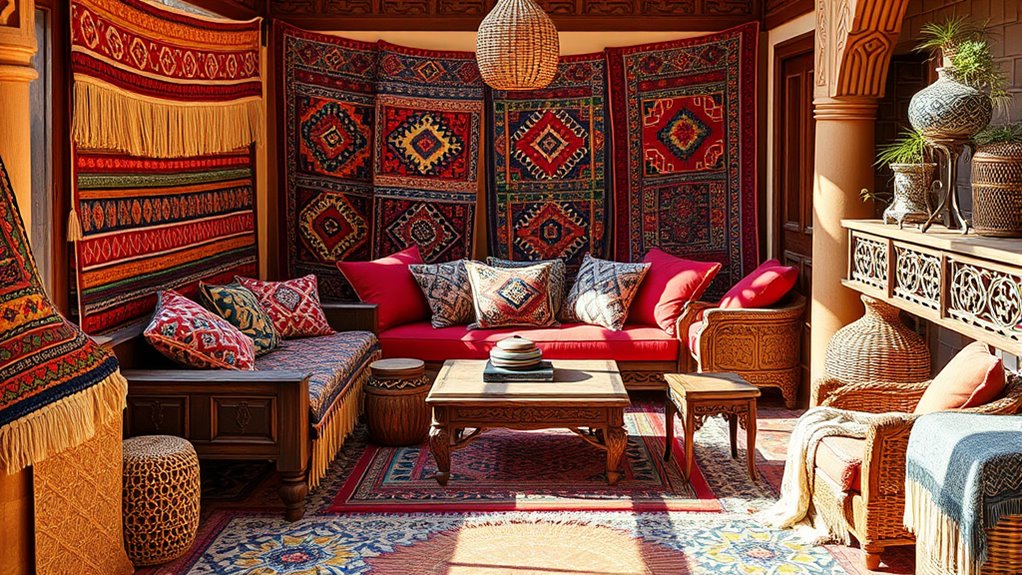
You’ll notice that Moroccan fabrics showcase rich Berber weaves, each telling a story through intricate patterns. Vibrant kilim designs add bold colors and geometric shapes that catch the eye. These unique features highlight Morocco’s vibrant textile heritage and craftsmanship. Incorporating distinctive textile techniques can further enhance the authentic Moroccan aesthetic in your home decor.
Traditional Berber Weaves
Traditional Berber weaves are a vibrant expression of Morocco’s rich cultural heritage, showcasing a variety of fabrics each with distinct textures and patterns. Berber weaving is an intricate craft that reflects the history, beliefs, and daily life of the Berber people. Every textile carries symbolic meaning through its patterns, colors, and motifs, serving as a form of storytelling. These fabrics often feature geometric designs and bold contrasts, highlighting the artisans’ skill and cultural identity. Incorporating artistic expression into your home allows you to celebrate the creativity and traditions of Moroccan craftsmanship. As you incorporate Berber weaves into your home, you bring a piece of Morocco’s history and symbolism with you. Whether used as rugs, wall hangings, or upholstery, these textiles add warmth, character, and a deep cultural connection that elevates your space with authenticity.
Vibrant Kilim Patterns
Vibrant kilim patterns are a defining feature of Moroccan textiles, distinguished by their bold colors and geometric motifs. These patterns often carry cultural symbolism, representing stories, beliefs, and regional identities. When choosing kilims, look for options with sustainable sourcing to support eco-friendly practices. The intricate designs reflect a blend of tradition and artistry, making each piece unique. Moroccan kilims are crafted using natural dyes and locally sourced wool, emphasizing sustainability. The geometric motifs, such as diamonds and zigzags, symbolize protection and fertility. Additionally, handwoven techniques contribute to the durability and authenticity of each kilim. Below is a quick overview:
| Pattern Type | Cultural Symbolism | Sustainability Aspect |
|---|---|---|
| Diamond | Protection | Natural dyes |
| Zigzag | Water & Life | Locally sourced wool |
| Striped | Unity & Connection | Eco-friendly dyes |
| Hexagon | Fertility | Handwoven techniques |
| Circular | Eternity | Sustainable fibers |
Incorporating Moroccan Rugs and Tapestries Into Your Space
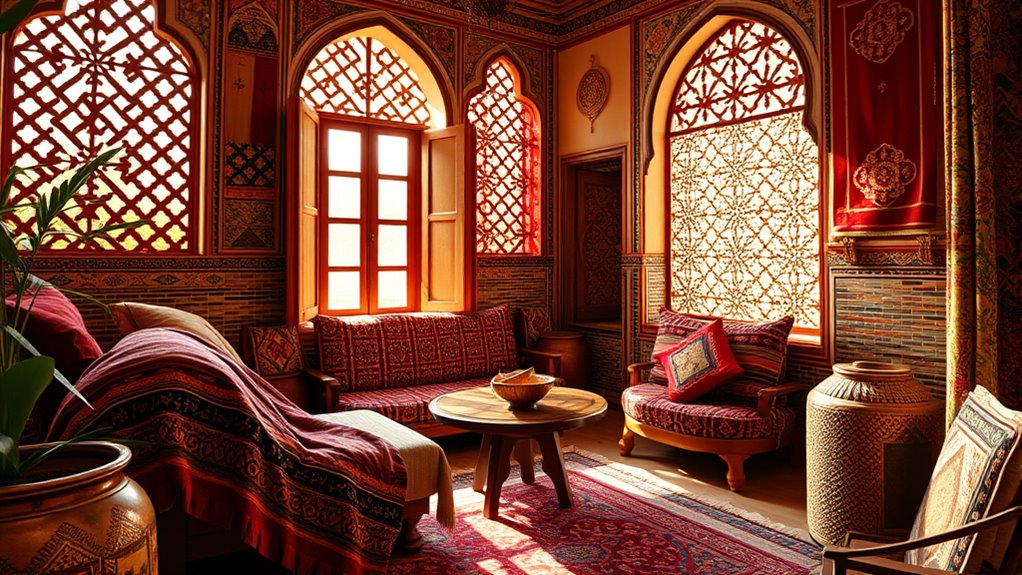
When choosing Moroccan rugs and tapestries, focus on patterns that complement your existing decor and add visual interest. Think about placement—layering pieces can create depth and warmth in your space. Experiment with different arrangements to find what feels most inviting and authentic to your style. Incorporate vintage decor and natural materials to enhance the exotic charm of your textiles.
Choosing the Right Patterns
Choosing the right patterns for your Moroccan rugs and tapestries can transform your space into a mesmerizing oasis. Focus on geometric motifs that add visual interest and reflect authentic Moroccan design. Consider how the patterns blend with your existing décor and aim for harmony through color coordination. To create a balanced look, think about these tips:
- Match patterns with wall colors for seamless integration
- Use bold geometric motifs as statement pieces
- Mix smaller and larger patterns for depth
- Pair intricate tapestries with simpler furniture
- Choose patterns that complement your room’s overall style
- Incorporate visual harmony by balancing patterns and colors to avoid clutter and create a cohesive atmosphere.
Placement and Layering Tips
Incorporating Moroccan rugs and tapestries into your space starts with thoughtful placement and layering techniques that enhance their visual impact. Begin by identifying a focal point, such as a seating area or bed, and anchor it with a vibrant rug. Use layering techniques by placing smaller textiles over larger rugs or arranging multiple tapestries to create depth and texture. Don’t be afraid to mix patterns and textures, but keep the color palette cohesive to avoid visual clutter. Position tapestries on prominent walls to serve as statement pieces or drape them over furniture for added warmth. The goal is to create a balanced, inviting space that highlights the exotic charm of Moroccan textiles while maintaining harmony. Carefully layered textiles invite both comfort and visual interest. Additionally, considering the use of hydrocolloid technology in skincare can help protect your skin while layering different textiles and accessories.
The Art of Moroccan Tilework: Zellige and Beyond
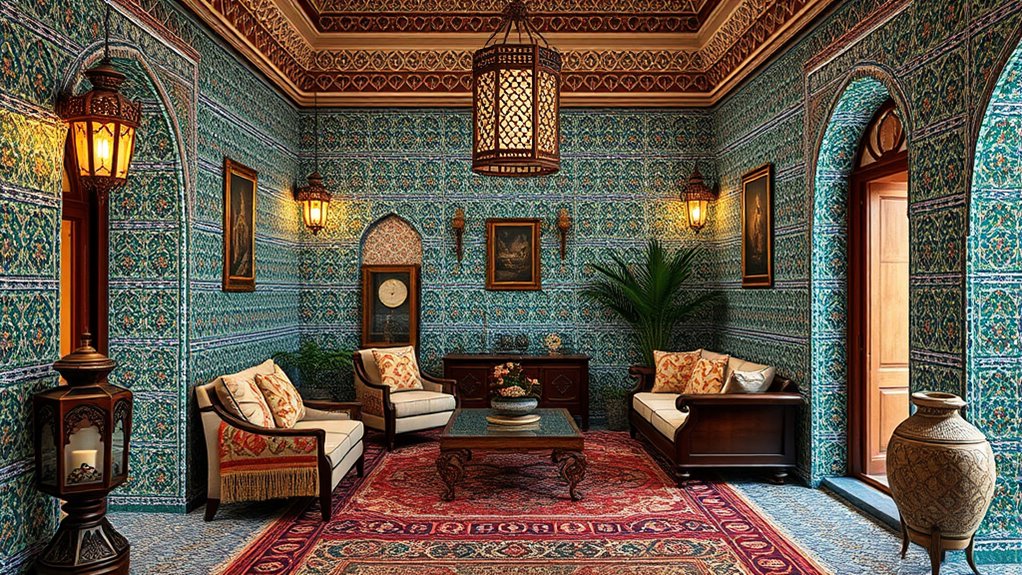
Moroccan tilework, especially the renowned art of Zellige, showcases intricate craftsmanship and vibrant patterns that have been perfected over centuries. These tiles reflect a rich history, blending geometric precision with artistic flair. You’ll notice how Moroccan tile patterns often emphasize symmetry and color harmony, creating striking visual effects. Zellige craftsmanship involves hand-cut terracotta tiles glazed with vibrant colors, then meticulously assembled into complex mosaics. To incorporate this timeless art into your space, consider:
- Installing a Zellige backsplash in your kitchen
- Adorning a fireplace surround with Moroccan tile patterns
- Creating a decorative accent wall with hand-cut mosaics
- Using tiles to frame mirrors or artwork
- Incorporating geometric designs into tabletops or flooring
This craftsmanship brings an authentic Moroccan charm, enriching your home’s aesthetic with cultural depth. Attention to craftsmanship ensures that each piece embodies centuries of tradition and artistic skill.
Choosing the Right Color Palette for a Moroccan-Inspired Room
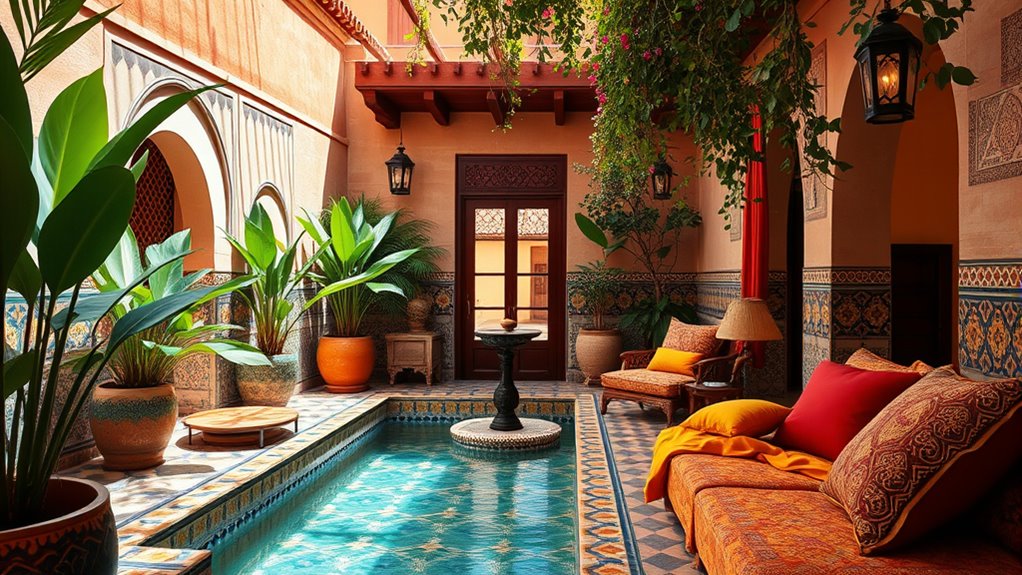
To evoke the vibrant and warm atmosphere typical of Moroccan design, selecting the right color palette is essential. Consider color psychology to choose hues that create the mood you desire—rich reds, deep blues, and earthy terracottas evoke warmth and intimacy. Bright accents like turquoise or gold can add a touch of luxury. Lighting considerations play a vital role; natural light enhances warm tones, making spaces feel inviting, while dimmer lighting can deepen jewel tones for a cozy vibe. Balance bold colors with neutral shades to prevent overwhelm, ensuring your room feels harmonious. Focus on creating a cohesive look that reflects Morocco’s lively spirit, using color as a foundation. With thoughtful selection, your space will radiate authentic Moroccan charm.
Mixing and Matching Patterns for a Cohesive Look
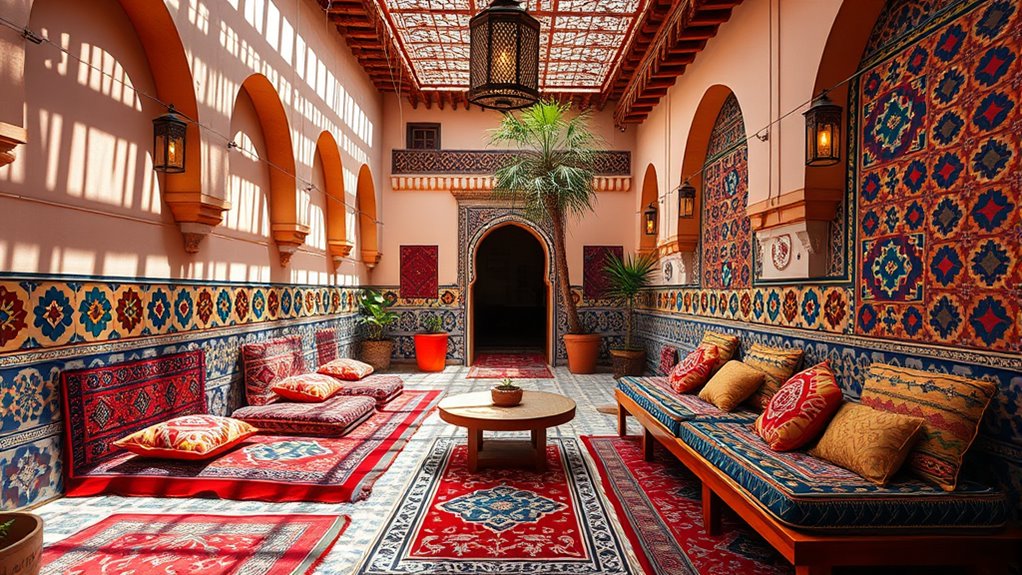
When mixing and matching patterns in a Moroccan-inspired space, it’s important to strike a balance that feels lively yet harmonious. Focus on color coordination to ensure different patterns complement each other without clashing. Use pattern contrast thoughtfully—pair bold geometric designs with softer, more intricate textiles to create visual interest. To achieve cohesion, consider these tips:
- Limit your palette to a few harmonious colors.
- Vary pattern sizes to prevent overwhelming the space.
- Combine traditional motifs with contemporary designs.
- Use neutral backgrounds to let patterns stand out.
- Mix textiles, tiles, and rugs for layered depth.
Additionally, understanding visual harmony can help you create a balanced and appealing environment.
DIY Ideas for Incorporating Moroccan Elements
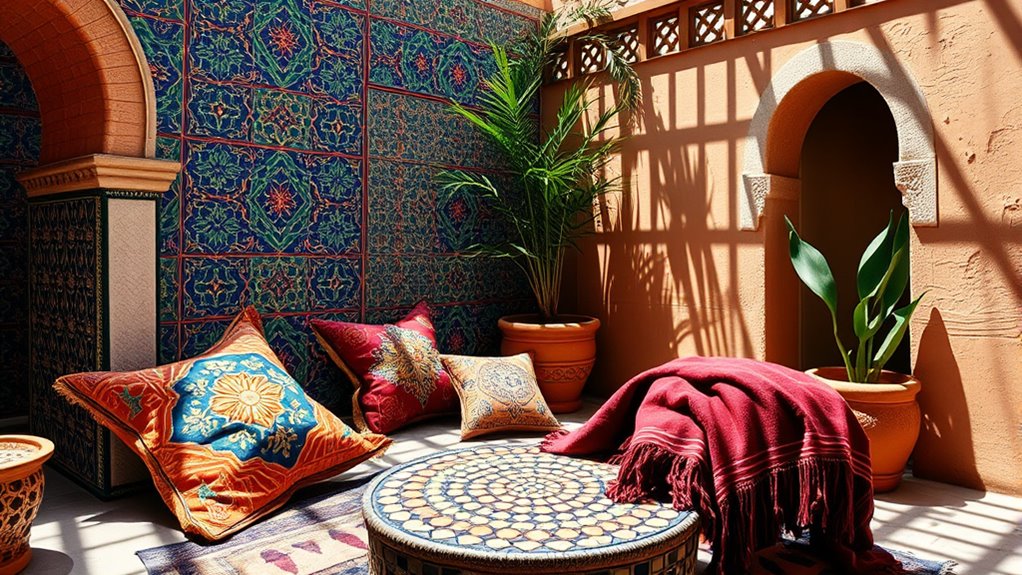
Adding Moroccan elements to your space doesn’t have to be costly or complicated; with a few creative DIY projects, you can easily infuse vibrant, authentic touches. Start by creating wall art inspired by Moroccan architecture, such as stenciled designs or paper cutouts resembling arches and intricate patterns. Incorporate traditional music by repurposing old musical instruments or framing colorful album covers to add cultural flair. You can also craft your own lanterns using metal or glass, mimicking Moroccan lighting. Adding textiles like hand-stitched cushion covers or table runners with bold geometric patterns enhances the atmosphere. These simple projects bring a lively Moroccan vibe into your home, celebrating the richness of Moroccan architecture and the soulful sound of traditional music without a hefty price tag. For a truly authentic touch, consider incorporating traditional textiles, which feature vibrant colors and intricate patterns to elevate your decor.
Where to Find Authentic Moroccan Decor Pieces
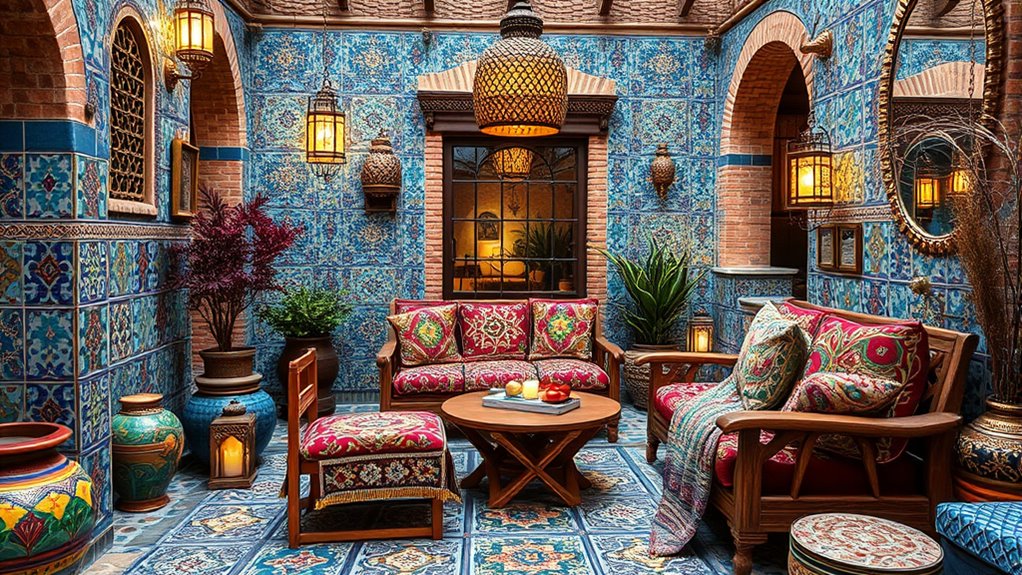
Finding authentic Moroccan decor pieces can transform your space into a vibrant oasis. To uncover genuine items, explore specialty markets, local artisan shops, and online boutiques dedicated to Moroccan crafts. Visiting Moroccan festivals can also be a treasure trove of unique decor, as vendors often sell textiles, ceramics, and jewelry directly from artisans. For a truly immersive experience, consider traveling to Morocco itself, where souks burst with handcrafted tiles and textiles. Additionally, you can find authentic pieces in ethnic home decor stores and through reputable importers who focus on Moroccan culture. Keep an eye out for items like Moroccan cuisine-inspired pottery, vibrant rugs, lanterns, and metalwork that reflect the country’s rich heritage. These sources ensure you get genuine, high-quality Moroccan decor for your home.
Tips for Maintaining and Caring for Moroccan Textiles and Tiles
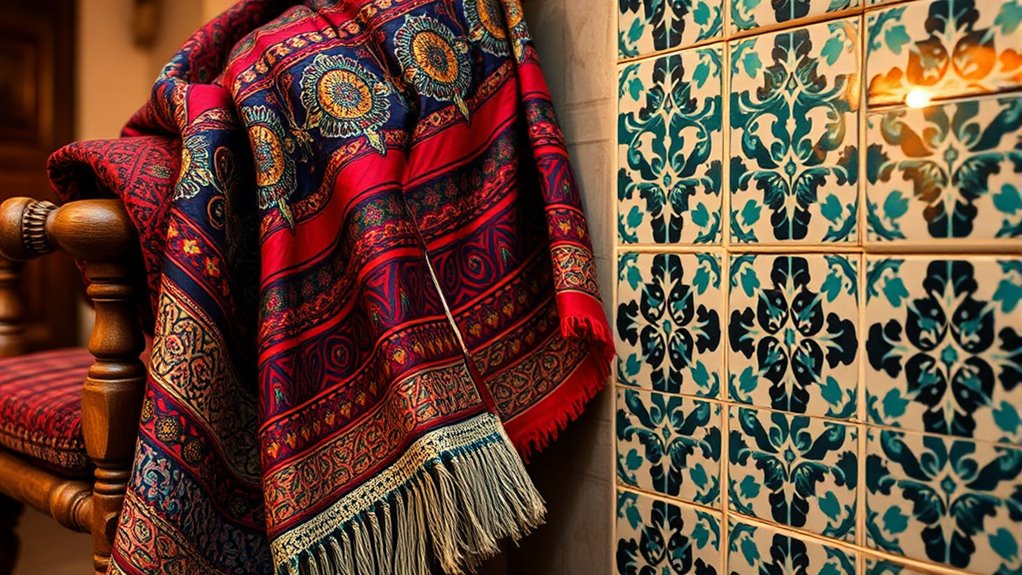
To keep your Moroccan textiles and tiles looking their best, regular care and mindful maintenance are essential. For textile preservation, avoid direct sunlight to prevent fading, and gently vacuum or shake out textiles to remove dust. When cleaning textiles, use mild detergents and avoid harsh chemicals to maintain their vibrant colors and intricate patterns. For tiles, employ proper tile cleaning techniques—use a soft brush or cloth with warm water and a gentle cleaner to remove dirt without damaging the surface. Steer clear of abrasive scrubbers that could scratch or dull the tiles’ delicate finishes. Regularly inspect for cracks or wear, addressing issues early to prolong their beauty and durability. With consistent, gentle care, your Moroccan textiles and tiles will remain stunning for years to come.
Frequently Asked Questions
How Can I Incorporate Moroccan Design Elements Into a Modern Minimalist Home?
To incorporate Moroccan design into your modern minimalist home, use fusion techniques that blend traditional patterns with sleek furniture. Focus on a warm, earthy color palette—think terracotta, deep blues, and gold accents—that add richness without overwhelming. Incorporate Moroccan textiles like rugs or cushions for texture, and add subtle tile accents to create visual interest. Keep the overall space uncluttered, letting these elements shine while maintaining your minimalist aesthetic.
Are Moroccan Textiles Suitable for Outdoor Use or Only Indoor Spaces?
Moroccan textiles can be used outdoors if they have good weather resistance, but many are best suited for indoor spaces. To keep them looking their best outside, use weather-resistant fabrics or treat them with protective coatings. Regular cleaning tips include gentle vacuuming and spot cleaning with mild soap and water. Keep in mind, outdoor exposure might shorten their lifespan, so consider indoor placement for longevity and vibrant colors.
What Are the Best Maintenance Practices to Preserve Moroccan Tiles’ Vibrancy?
Think of your Moroccan tiles as vibrant jewels needing care. To preserve their brilliance, follow regular cleaning routines with gentle, pH-neutral cleaners. Sealing techniques are essential; apply a high-quality sealant to prevent stains and moisture damage. I once restored a Moroccan patio, and consistent maintenance kept the colors vivid for years. With proper care, your tiles will continue to radiate beauty and cultural richness.
Can Moroccan-Inspired Decor Be Integrated Into a Small or Studio Apartment?
You can easily incorporate Moroccan-inspired decor into a small or studio apartment by choosing space-saving furniture that maximizes your limited space. Use vibrant textiles and colorful tiles as accents to add warmth and personality. Focus on color coordination to keep the space cohesive and avoid visual clutter. Small decorative pieces, like patterned cushions or a mosaic mirror, can create an exotic vibe without overwhelming your compact living area.
What Are Common Mistakes to Avoid When Decorating With Moroccan Textiles and Tiles?
Think of your decor as a story, not a jigsaw puzzle. When decorating with Moroccan textiles and tiles, avoid common mistakes like poor color coordination and pattern clash. You might love bold patterns, but mixing too many can overwhelm. Instead, balance intricate textiles with neutral tiles, and harmonize colors to create a cohesive look. Remember, the goal is to enhance, not overpower, your space with Moroccan charm.
Conclusion
By embracing Moroccan textiles and tiles, you’ll transform your home into a stunning oasis bursting with color and character. With a little creativity, you can create a space so mesmerizing, it’ll make even the most worldly traveler feel right at home. So go ahead—dive into this exotic world, and let your décor become a masterpiece that turns your everyday living into an unforgettable Moroccan adventure!
